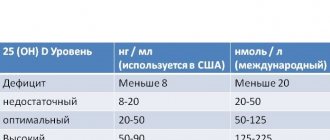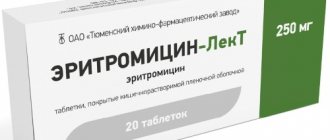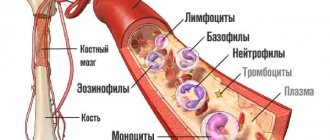Erythrocyte sedimentation rate is a biological parameter that determines the ratio of proteins and blood elements. ESR is an important parameter of a general blood test, since sedimentation rates change in some diseases and specific conditions of the body. When infectious and inflammatory reactions occur in the body, a large number of protein compounds are released into the blood (proteins of the acute phase of inflammation). During laboratory testing, red blood cells stick together under the influence of proteins and then settle to the bottom of the test tube.
The essence of the study is to measure the sedimentation rate: the more proteins there are in the plasma (markers of inflammatory processes in the body), the faster the red blood cells form fractions and settle.
General information
New methods for diagnosing and determining the causes of diseases appear in modern medicine regularly. However, determining ESR in human blood is still an effective diagnostic method.
It is used for diagnostic purposes in both children and adults. Such a study is prescribed both when a patient who is concerned about a certain disease contacts a doctor, and during preventive examinations. Any doctor can interpret this test. ESR is included in the group of general blood tests (CBC). If this indicator is elevated, you need to determine the cause of this phenomenon.
What is ESR in the blood?
Those who are prescribed such a study are interested in why an ESR analysis is performed and what it is. So, the abbreviation ESR is the capital letters of the term “ erythrocyte sedimentation rate ”. Thus, using this test, the erythrocyte in the blood can be accurately determined.
Erythrocytes are, as you know, red blood cells. anticoagulants act on them over a certain period, they settle at the bottom of the capillary or test tube. The time during which a blood sample taken from a patient is divided into upper and lower layers is defined as ESR. It is assessed by the height plasma layer , which was obtained during the research process, in millimeters per 1 hour. The ESR indicator is nonspecific, however, it has high sensitivity.
If the ESR level in the blood is elevated, this may indicate the development of various disorders in the body. So, sometimes this is an indicator of the development of infectious, oncological, rheumatological and other pathologies even before the manifestation of obvious symptoms of diseases. Accordingly, if the ESR level is normal, the doctor, if necessary, prescribes other tests.
The ESR norm for women is 3 to 15 mm/h. But you need to take into account that this indicator also depends on age - normally it can be different for women under 30 and after 30 years. If necessary, the norm of red blood cells in the blood of women is also determined. In pregnant women, ESR increases starting from the fourth month. It should be taken into account that the ESR rate in pregnant women may vary depending on the period of gestation.
The norm for ESR in men is from 2 to 10 mm/h. A general blood test also determines red blood cells in the blood of men.
The normal ESR level in the blood of children depends on the age of the patient.
This value in the diagnostic process is important for:
- differentiation of diagnosis ( appendicitis and ectopic pregnancy , angina pectoris and myocardial infarction , rheumatoid arthritis and osteoarthritis , etc.);
- determining the body's response during the treatment of patients with tuberculosis , lymphogranulomatosis , rheumatoid arthritis , etc.;
- determining a disease that occurs latently (but it should be borne in mind that even normal ESR values do not exclude the development of a disease or neoplasm in the body).
Sometimes this concept is referred to as ROE . ROE in the blood and ESR are identical concepts. Speaking about ROE in the blood, we understand that this is an erythrocyte sedimentation reaction . Once upon a time, this very concept was used in medicine, that is, the norm of ROE in the blood for women, the norm of ROE in the blood of children, etc. were determined. Currently, this concept is considered outdated, but any doctor understands what ROE is in a blood test, what ROE is in oncology, etc.
Methods for determining ESR
There are several methods for determining the erythrocyte sedimentation rate: according to Panchenkov, according to Westergren, according to Wintrobe, microESR. These laboratory research methods differ in the method of blood sampling, the technique of conducting laboratory research and the dimensional scale of the results.
Panchenkov method
This method is used in public hospital laboratories and is included in a general blood test, for which biological material is taken from a finger.
During the study, a Panchenkov apparatus is used, which consists of a tripod into which special capillaries (thin tubes) with size marks are inserted.
After drawing blood from a finger, a reagent (sodium citrate solution) is added to the laboratory capillary to prevent coagulation (formation of a dense clot). Next, the biological material is placed in a capillary with a measuring scale of 100 divisions.
After an hour, the laboratory assistant determines how many millimeters the fractions of clumped red blood cells drop in 1 hour.
Westergen method
The Westergen determination method is used for a more accurate diagnosis of inflammatory processes and is an international laboratory research method.
The collection of biological material for the method of determining ESR according to Westergen is carried out from a vein on an empty stomach. The biological material is added to a test tube with a reagent (sodium citrate) that prevents clotting.
There are 200 divisions on the test tube using the Westergen method, which allows for a more accurate determination of ESR. The units of measurement for this indicator are similar in both versions of the study - millimeters per hour (mm/h).
There are factors that affect the accuracy of the analysis results, namely:
- temperature in the laboratory where the research is being carried out (at a temperature of more than 25 degrees Celsius, the ESR value increases, and if it is less than 18 degrees, a low erythrocyte sedimentation rate is detected);
- storage time (if biological material is stored for more than 4 hours before laboratory analysis);
- reagent used;
- degree of dilution and quality of mixing of biological material with the reagent;
- correct installation of the capillary in the tripod;
- using a plastic capillary instead of a glass one.
Taking into account possible errors, if ESR values are too high or low for no apparent reason, it is necessary to re-take the test to confirm the pathology.
Diseases in which there is an increased ESR in the blood
If a patient has an elevated ESR in the blood, what this means is determined by the doctor during the diagnostic process. After all, this indicator is very important for diagnosis if the development of a certain disease is suspected. In the diagnostic process, a qualified doctor takes into account not only the fact that the patient has an increased value, but also determines what the presence of other symptoms indicates. But still this indicator is very important in many cases.
ESR: increased in diseases
An increased ESR in the blood of a child and an adult is observed if a bacterial infection - during the acute phase of a bacterial infection.
In this case, it does not matter where exactly the infections are localized: the picture of the peripheral blood will still reflect the inflammatory reaction.
viral infectious diseases occur . What specifically causes this indicator to increase is determined by the doctor during a comprehensive examination.
Thus, we are talking about the development of a certain pathological process if the ESR is higher than normal. What this means depends on the value of the indicator. Very high values – more than 100 mm/h – occur with the development of infectious diseases:
- for sinusitis , bronchitis , pneumonia , ARVI , colds , tuberculosis , influenza , etc.;
- for cystitis , pyelonephritis and other urinary tract infections ;
- for fungal infections , viral hepatitis ;
- in oncology (high rates can be observed for a long time).
During the development of an infectious disease, this value does not increase quickly; an increase is observed after 1-2 days. If the patient has recovered, the ESR will be slightly elevated for several more weeks or months. The reasons for a high ESR with normal leukocytes may indicate that the person has recently suffered a viral disease: that is, the leukocyte count has already returned to normal, but the red cell sedimentation rate has not yet.
The reasons for increased ESR in the blood in women may be associated with pregnancy, therefore, in the diagnostic process, the doctor must take into account these reasons for the increase in ESR in the blood in women.
An increase in ESR is a typical symptom in the following diseases:
- diseases of the biliary tract and liver;
- inflammatory diseases of a purulent and septic nature ( reactive arthritis , etc.);
- blood diseases ( sickle anemia , hemoglobinopathies , anisocytosis );
- ailments in which tissue destruction and necrosis ( stroke , heart attack , tuberculosis , malignant neoplasms);
- pathologies of the endocrine glands and metabolic disorders ( obesity , diabetes , cystic fibrosis , etc.);
- malignant degeneration of the bone marrow, in which red blood cells enter the blood that are not ready to perform direct functions ( myeloma , leukemia , lymphoma );
- autoimmune diseases ( scleroderma , lupus erythematosus , rheumatism , etc.);
- acute conditions in which the blood becomes more viscous ( diarrhea , bleeding , vomiting , postoperative conditions , etc.).
ESR above 100 mm/h – what to do? What does it indicate?
A significant increase in ESR in cancer patients may indicate metastasis—the spread of the tumor beyond the primary site.
The only case of diagnostic use of accelerated ESR (100 mm/hour and above) in oncology is the detection of multiple myeloma (malignant bone marrow disease).
Very high ESR values also occur in Hodgkin lymphomas.
Analysis of ESR in neoplasms is often used not for diagnosis, but for dynamic assessment of the effectiveness of treatment and monitoring the course of the disease.
Normal and pathological ESR values
In medicine, the physiological limits of this indicator are determined, which are the norm for certain groups of people. Normal and maximum values are shown in the table:
| In children (value depends on the age of the child) | Among women | In men |
|
|
|
ESR during pregnancy
If this value is increased during pregnancy , this is considered a normal condition. The normal ESR rate during pregnancy is up to 45 mm/h. With such values, the expectant mother does not need to be further examined and the development of pathology is not suspected.
What ELSE do ESR indicators in women depend on?
Moderate (up to 40-50 mm/hour) acceleration of ESR can periodically appear in completely healthy women.
Such a physiological increase in ESR may be associated with menstruation, pregnancy, errors in diet (high-protein diet, abuse of fatty foods, overeating, alcohol), physical overload, excess body weight, stress, age-related changes in the body... A slight increase in ESR in women cannot be considered an unconditional marker of inflammation or other pathology How some drugs act on ESR
| Group of drugs | Impact on ESR |
| Hormonal contraceptives | Promotion |
| Other estrogen-containing medicines | Promotion |
| NSAIDs (non-steroidal anti-inflammatory drugs) in moderate doses | Decline |
| Aspirin in high doses | Promotion |
| Glucocorticoids (hydrocortisone, etc.) | Decline |
| Cephalosporins | Promotion |
| Macrolides (erythromycin, roxithromycin) | Promotion |
| Vitamin B2 (riboflavin) | Promotion |
| Iron supplements | Sometimes: promotion |
| Anticonvulsants | Promotion |
Increased ESR during pregnancy
In pregnant women, ESR accelerates: the longer the pregnancy, the higher the ESR.
From the third trimester, ESR can exceed the norm by 3 times and reach 45-50 mm/hour.
After childbirth, the ESR remains accelerated from three months to six months, then gradually decreases and returns to normal on its own.
Methods used to test ESR blood
Before deciphering what ESR means in a blood test, the doctor uses a certain method to determine this indicator. It should be noted that the results of different methods differ and are not comparable.
Before performing an ESR blood test, it must be taken into account that the obtained value depends on several factors. The general analysis must be carried out by a specialist - a laboratory employee, and only high-quality reagents are used. The analysis in children, women and men is carried out provided that the patient has not eaten food for at least 4 hours before the procedure.
What does the ESR value show in the analysis? First of all, the presence and intensity of inflammation in the body. Therefore, if there are abnormalities, patients are often prescribed a biochemical analysis. Indeed, for high-quality diagnostics it is often necessary to find out in what quantity a certain protein is present in the body.
ESR according to Westergren: what is it?
The described method for determining ESR - the Westergren method - currently meets the requirements of the International Committee for Standardization of Blood Studies. This technique is widely used in modern diagnostics. For such an analysis, venous blood is needed, which is mixed with sodium citrate . To measure ESR, the distance of the stand is measured, the measurement is taken from the upper limit of the plasma to the upper limit of the red blood cells that have settled. The measurement is carried out 1 hour after the components have been mixed.
It should be noted that if Westergren's ESR is elevated, this means that this result is more indicative for diagnosis, especially if the reaction is accelerated.
ESR according to Wintrob
The essence of the Wintrobe method is the study of undiluted blood that was mixed with an anticoagulant. The desired indicator can be interpreted using the scale of the tube in which the blood is located. However, this method has a significant drawback: if the reading is above 60 mm/h, the results may be unreliable due to the fact that the tube is clogged with settled red blood cells.
ESR according to Panchenkov
This method involves the study of capillary blood, which is diluted with sodium citrate - 4:1. Next, the blood is placed in a special capillary with 100 divisions for 1 hour. It should be noted that when using the Westergren and Panchenkov methods, the same results are obtained, but if the speed is increased, then the Westergren method shows higher values. Comparison of indicators is in the table below.
| According to Panchenkov (mm/h) | Westergren (mm/h) |
| 15 | 14 |
| 16 | 15 |
| 20 | 18 |
| 22 | 20 |
| 30 | 26 |
| 36 | 30 |
| 40 | 33 |
| 49 | 40 |
Currently, special automatic counters are also actively used to determine this indicator. To do this, the laboratory assistant no longer needs to dilute the blood manually and track the numbers.
Rules for taking a blood test
There are two ways to donate blood to determine the ESR value (from a vein and from a finger). Both options are effective. Only the laboratory research method will change.
In this case, you must follow several doctor’s recommendations (otherwise, the test results may be unreliable):
- Blood is donated in the morning on an empty stomach, so you should not eat anything in the morning. Often, along with a blood test for ESR, doctors give a referral to check your sugar levels. In this case, you do not need to eat or brush your teeth 12 hours before the procedure. Only drinking a small amount of water is allowed.
- The day before taking a general blood test, you should stop drinking alcoholic beverages and cigarettes. If the patient cannot withstand such a long period without cigarettes, it is advisable not to smoke at least in the morning before the procedure.
- The day before the appointed date, you should not take medications. First of all, this rule applies to multivitamins and hormonal products. If it is impossible to interrupt the course of treatment, the laboratory technician must be informed about this. A note will be made to correct the results.
- Donating blood from a vein is a big burden for the body (in physiological and psychological aspects). Before the procedure, you should come to the clinic a little earlier to calm down. On this day, it is advisable to avoid heavy physical activity.
- The day before the test, you should adjust your diet, which means eliminating fatty, smoked and spicy foods.
Important information: What are monocytes in the blood and a table of norms by age of women
ESR in the blood: what do certain values mean?
As mentioned above, normal ESR values for a healthy man are considered to be 1, 2, 3, 4, 5, 6, 7, 8, 9, 10 mm per hour; for women, the normal value is from 2 to 15 mm/hour. Therefore, for women, a value of 12, 13, 14, 15 is considered normal. However, indicators for women in adulthood can normally be 16, 17, 18, 19, 20.
If the value exceeds the norm by several units, then the blood condition can be considered relatively normal. That is, an indicator of 21, 22 in a woman can be considered acceptable, as well as values of 23, 24 mm/h. When a woman is pregnant, this meaning is even greater. Therefore, expectant mothers have no reason to believe that a reading of 25 means something unpleasant. During pregnancy, the analysis may show 28, 29. ESR 30, 31, 32, 33, 34, 35, 36, 38 is also not evidence of the development of pathological processes in pregnant women.
This indicator increases with age. Therefore, if an ESR value of 40 is noted in elderly patients, the doctor determines what disease this is a symptom of and what it means by the accompanying signs. Normal values for older people are 43, 50, 52, 55 mm/h, etc. However, for young people, values of 40-60 mm/h are possibly evidence of serious disorders. Therefore, after receiving the analysis data, it is necessary to consult in detail about why the ESR is 60, what it could be, and undergo further research.
Low value
As a rule, the reasons for a low value of this indicator are associated with exhaustion of the body, weight loss, taking corticosteroids, hyperhydration, and muscle atrophy. Sometimes ESR is lowered in diseases of the heart and blood vessels.
What affects the ESR indicator?
In both women and men, the level of ESR is influenced by a number of different factors, both physiological and pathological. The key factors that most influence this analysis are identified:
- When determined by different methods - according to Westergren et al. - the norm of ESR in the blood of women is higher than that of men. So, an ESR of 25 in a woman may be normal. This is due to the physiological characteristics of blood in women.
- What is the normal ESR level in a woman’s blood depends on whether she is pregnant. For expectant mothers, the norm is from 20 to 45 mm/h.
- A higher ESR is observed in women who take contraceptives . Under this condition, a woman may have a normal ESR of 30. What this means, whether there is a pathology, or whether we are talking about a normal physiological indicator, must be determined by the doctor.
- In the morning, the rate at which red cells settle is higher than in the afternoon and evening, and differences in age do not matter here.
- Signs of accelerated sedimentation are observed when exposed to acute phase proteins.
- If inflammation and an infectious process develops, the values change a day later. how leukocytosis and hyperthermia . That is, on the first day of the disease the indicator can be 10, 14, 15 mm/h, and a day later it can increase to 17, 18, 20, 27, etc.
- ESR is elevated if there is a chronic source of inflammation in the body.
- A reduced value is observed with increased blood viscosity .
- A decrease in sedimentation rate occurs under the influence of anisocytes and spherocytes; the rate becomes greater under the influence of macrocytes.
ESR - why do red blood cells settle?
Normally, red blood cells - erythrocytes - carry a negative charge. According to the laws of physics, they, being equally charged, repel each other and “float” in the plasma without sticking together. When, under the influence of gravity, red blood cells “fall” down one by one, their sedimentation rate is low.
When the biochemical composition of blood plasma changes, more often when the normal balance between its protein fractions is disrupted, the negative charge of erythrocytes is neutralized. Positively charged proteins, like “bridges,” connect (aggregate) red blood cells with each other into “coin columns.”
Erythrocyte-protein conglomerates are much heavier than individual cells. Therefore, they settle down at a faster rate and the ESR increases.
Proteins that increase erythrocyte aggregation and accelerate ESR:
- Fibrinogen is a marker of inflammatory and destructive processes. Produced in the liver. Its concentration in the blood increases significantly during acute inflammatory processes, as well as in response to the destruction and death (necrosis) of tissues.
- Globulins (including immunoglobulins) are high molecular weight proteins in blood plasma. Produced in the liver, as well as by the immune system. The concentration of immunoglobulins (antibodies) in the blood increases in response to infection.
- Mixed cryoglobulins - in particular, polyclonal Ig G antibodies and monoclonal antibodies Ig M and Ig G to the Fc fragment of Ig G. The combination of the latter is called rheumatoid factor.
Read more: Rheumatoid factor (Rheumofaktor) is elevated in a blood test - what to do?
Any physiological conditions, nutritional disorders or diseases associated with an increase in these or other proteins in the plasma are manifested by an increase in ESR.
Dysproteinemia is a violation of the quantitative ratio of proteins in the blood.
ESR is a sign of dysproteinemia. The more pronounced the dysproteinemia, the higher the ESR. The ESR norm is not the same for women and men. This is probably due to fewer red blood cells and more fibrinogen and globulins in women.
Elevated ESR in children
When the ESR norm in children is exceeded, most likely an infectious inflammatory process develops in the body. But it should be taken into account, when determining ESR according to Panchenkov, that other indicators of the CBC ( hemoglobin , etc.) are also increased (or changed) in children. Also, in children with infectious diseases, their general condition worsens significantly. In case of infectious diseases, the ESR is high in the child already on the second or third day. The indicator can be 15, 25, 30 mm/h.
If red blood cells are elevated in a child’s blood, the reasons for this condition may be the following:
- metabolic disorders ( diabetes , hypothyroidism , hyperthyroidism );
- systemic or autoimmune diseases ( bronchial asthma , rheumatoid arthritis , lupus );
- blood diseases , hemoblastosis , anemia ;
- diseases in which tissue decay occurs ( tuberculosis , myocardial infarction , cancer ).
It is necessary to take into account: if even after recovery the erythrocyte sedimentation rate is increased, this means that the process is proceeding normally. It’s just that normalization is slow, but after about one month after the disease, normal levels should be restored. But if there are doubts about recovery, then you need to do a re-examination.
Parents must understand that if a child’s red blood cells are higher than normal, this means that a pathological process is taking place in the body.
But sometimes, if a baby’s red blood cells are slightly elevated, this means that some relatively “harmless” factors are influencing:
- in infants, a slight increase in ESR may be associated with a violation of the mother's diet during natural feeding ;
- period of teething;
- after taking medications ( Paracetamol );
- with a lack of vitamins ;
- with helminthiasis .
Thus, if red blood cells are elevated in the blood, this means that the child is developing a certain disease. There are also statistics on the frequency of increase in this value in various diseases:
- in 40% of cases, a high value indicates infectious diseases ( respiratory tract diseases , tuberculosis , urinary tract diseases , viral hepatitis , fungal diseases );
- in 23% - oncological processes of various organs;
- in 17% - rheumatism , systemic lupus ;
- in 8% - cholelithiasis , inflammation of the gastrointestinal tract , pelvic organs , anemia, ENT diseases , injuries , diabetes , pregnancy ;
- 3% — kidney disease.
For cancer
Suspicion of oncological processes in the body arises if the ESR value is higher than normal, despite long-term treatment with anti-inflammatory drugs (up to 70 mm/s). At the same time, the hemoglobin level decreases from 120-130 units to 70-80 units, and the level of leukocytes also increases.
A prolonged increase in the red blood cell sedimentation rate may indicate the formation of malignant tumors:
- intestinal tumors;
- cancerous tumors of the breast, cervix and ovaries in women;
- oncological processes in the bone marrow;
- brain tumors.
An increase in the ESR level also occurs with the development of benign tumors, namely:
- myeloma;
- polyps;
- papillomas;
- fibroids;
- lymphangiomas, etc.
Laboratory analysis of the ESR norm in women is not a direct indicator of the presence of cancer processes in the body, therefore, after determining the erythrocyte sedimentation rate of more than 70-80 mm/hour, an additional examination is carried out to confirm the diagnosis (ultrasound, magnetic resonance imaging, etc. ).
When can increasing ESR be considered safe?
As you know, an increase in red blood cells in the blood, as a rule, indicates that a certain inflammatory reaction is developing in the body. But sometimes the reasons for the increase in red blood cells in the blood of women and men are not so categorical.
We are talking, first of all, about allergies , when analysis in men and women helps to judge whether anti-allergy treatment is being carried out correctly (fluctuations in the initially elevated ESR should be taken into account). That is, if the clinical effect of the drug occurs, then gradually the normal ESR level in the blood of men, as well as in women, will be restored.
A hearty breakfast before the test can also increase this indicator; a strict diet and fasting can also change it.
ROE can change during menstruation, during pregnancy and after the birth of a child.
False-positive ESR tests
In medicine there is also the concept of a false positive analysis. An analysis of ESR is considered such if there are factors on which this value depends:
- anemia (no morphological changes in red blood cells occur);
- increase in the concentration of plasma proteins , with the exception of fibrinogen ;
- hypercholesterolemia;
- renal failure;
- obesity ;
- pregnancy;
- old age of a person;
- administration of dextran ;
- a technically incorrect study;
- taking vitamin A ;
- recent vaccination against hepatitis B.
What to do if the reasons for the increase are not determined?
If the analysis is normal, but the causes of the increased erythrocyte sedimentation rate cannot be determined, it is important to conduct a detailed diagnosis. It is necessary to exclude oncological diseases , so lymphocytes , GRA, and the norm of leukocytes in women and men are determined. During the analysis process, other indicators are also taken into account - whether the average volume of erythrocytes is increased (what this means - the doctor will explain) or whether the average volume of erythrocytes is decreased (what this means is also determined by the specialist). Urine tests and many other studies are also carried out.
But there are cases when high ESR levels are a feature of the body, and they cannot be reduced. In this case, experts advise regular medical examinations, and if a certain symptom or syndrome appears, consult a doctor.
Is it dangerous and what should I do?
The cause of an increased erythrocyte sedimentation rate is most often a disease. After identifying and eliminating the cause, the ESR indicator returns to normal on its own. However, in some cases, patients are prescribed ex juvantibus therapy. As part of this treatment, the following algorithm is used.
- First of all, broad-spectrum antibiotics are prescribed. These medications are aimed at eliminating inflammation in the body. As a result of this, the ESR returns to normal (the cause has been eliminated).
- If after taking antibiotics there is no effect, and the indicator remains at around 66-75, then an infection is excluded. The next stage is the prescription of steroidal anti-inflammatory drugs (most often glucocorticoids).
- In the absence of positive dynamics, the patient is referred for consultation to an oncologist.
This method is rarely resorted to in cases where there is a controversial diagnosis.
How to reduce ESR in the blood?
The doctor will tell you in detail about ways to reduce this indicator with the help of medications after the study. He will prescribe a treatment regimen once the diagnosis has been made. It is strictly not recommended to take medications on your own. You can try to reduce it with folk remedies, which are mainly aimed at restoring normal function of the immune system , as well as cleansing the blood. Effective folk remedies can be considered herbal decoctions, teas with raspberries and lemon, beet juice, etc. How many times a day to take these remedies, how much you need to drink, you should find out from a specialist.
Preparing for analysis
The most reliable test for examination will be blood from a vein. To determine ESR, a clinical blood test is performed. To assess the general condition of the body, all indicators of this analysis are taken into account.
In order for the results to be most reliable, simple preparation steps should be taken:
- The test takes place in the morning and on an empty stomach. For greater accuracy, you should abstain from eating at least 8 hours in advance. The day before, it is not recommended to eat highly fatty, fried and spicy foods. It is allowed to drink only a small amount of clean water without gas,
- It is advisable to give up alcohol and cigarettes 24 hours before the test.
- Stop taking medications that can affect ESR levels. Among the drugs are hormonal contraceptives, as well as multivitamins. If it is not possible to stop taking the medication, you need to inform your doctor about the use of medications so that he takes these deviations into account in the analysis results,
- It is recommended to arrive 10-15 minutes in advance so that you have time to catch your breath and calm down. Also, the day before and in the morning before the analysis, physical activity is not recommended,
- In case of menstruation, it is necessary to consult a doctor about the period. Since ESR indicators during menstruation increase.
All these measures are aimed at achieving the most accurate test results. Failure to comply with these steps may result in false results, which will lead to a retake.











